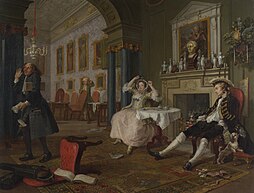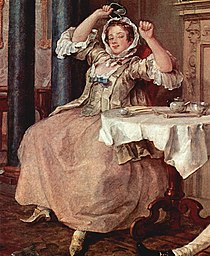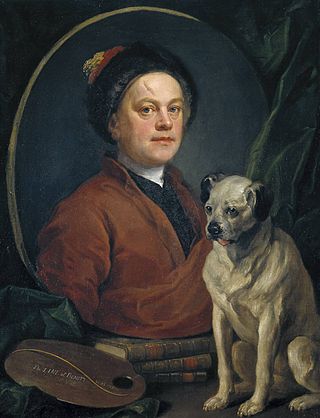
William Hogarth was an English painter, engraver, pictorial satirist, social critic, editorial cartoonist and occasional writer on art. His work ranges from realistic portraiture to comic strip-like series of pictures called "modern moral subjects", and he is perhaps best known for his series A Harlot's Progress, A Rake's Progress and Marriage A-la-Mode. Knowledge of his work is so pervasive that satirical political illustrations in this style are often referred to as "Hogarthian".
A Rake's Progress is a series of eight paintings by 18th-century English artist William Hogarth. The canvases were produced in 1732–1734, then engraved in 1734 and published in print form in 1735. The series shows the decline and fall of Tom Rakewell, the spendthrift son and heir of a rich merchant, who comes to London, wastes all his money on luxurious living, prostitution and gambling, and as a consequence is imprisoned in the Fleet Prison and ultimately Bethlem Hospital (Bedlam). The original paintings are in the collection of Sir John Soane's Museum in London, where they are normally on display for a short period each day.
A Harlot's Progress is a series of six paintings and engravings (1732) by the English artist William Hogarth. The series shows the story of a young woman, M. Hackabout, who arrives in London from the country and becomes a prostitute. The series was developed from the third image. After painting a prostitute in her boudoir in a garret on Drury Lane, Hogarth struck upon the idea of creating scenes from her earlier and later life. The title and allegory are reminiscent of John Bunyan's Pilgrim's Progress.

The Tête à Tête is the second canvas in the series of six satirical paintings known as Marriage A-la-Mode, painted by William Hogarth.

Four Times of the Day is a series of four oil paintings by English artist William Hogarth. They were completed in 1736 and in 1738 were reproduced and published as a series of four engravings. They are humorous depictions of life in the streets of London, the vagaries of fashion, and the interactions between the rich and poor. Unlike many of Hogarth's other series, such as A Harlot's Progress, A Rake's Progress, Industry and Idleness, and The Four Stages of Cruelty, it does not depict the story of an individual, but instead focuses on the society of the city in a humorous manner. Hogarth does not offer a judgment on whether the rich or poor are more deserving of the viewer's sympathies. In each scene, while the upper and middle classes tend to provide the focus, there are fewer moral comparisons than seen in some of his other works. Their dimensions are about 74 cm (29 in) by 61 cm (24 in) each.
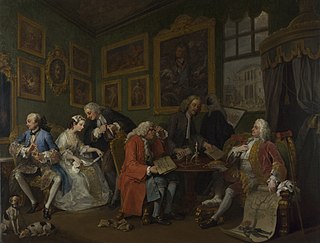
The Marriage Settlement is the first in the series of six satirical paintings known as Marriage A-la-Mode painted by William Hogarth, named after the historical legal arrangement of a Marriage settlement.

The Inspection is the third canvas in the series of six satirical paintings known as Marriage à-la-mode by William Hogarth.

The Toilette, called The countess's morning levee on the frame, is the fourth canvas in the series of six satirical paintings known as Marriage A-la-Mode painted by William Hogarth.

The Bagnio is the fifth canvas in the series of six satirical paintings known as Marriage A-la-Mode painted by William Hogarth.

The Lady's Death is the sixth and final canvas in the series of satirical paintings known as Marriage A-la-Mode painted by William Hogarth.

The Bench is the title of both a 1758 oil-on-canvas painting by the English artist William Hogarth, and a print issued by him in the same year. Unlike many of Hogarth's engravings produced from painted originals, the print differs considerably from the painting. It was intended as a demonstration of the differences between character painting, caricature and outré—developing on the theme he had begun to address in Characters and Caricaturas —but Hogarth was unhappy with the result as it showed only "characters", and he continued to work on the piece until his death.
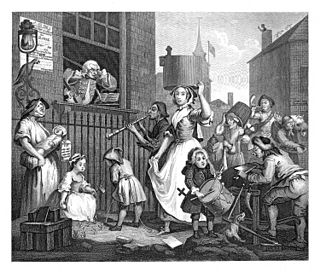
The Enraged Musician is a 1741 etching and engraving by English artist William Hogarth which depicts a comic scene of a violinist driven to distraction by the cacophony outside his window. It was issued as companion piece to the third state of his print of The Distrest Poet.

Sigismunda mourning over the Heart of Guiscardo, fully titled Sigismunda mourning over the Heart of Guiscardo, her murder'd Husband, is an oil painting by British artist William Hogarth. Finished in 1759, it was the principal piece of the eight works he displayed in an exhibition in 1761. It was the final and most ambitious of his attempts to secure for himself a reputation as a history painter. It depicts a dramatic moment in one of the novelle in Boccaccio's Decameron. While Hogarth had expected this work to be acclaimed as a masterpiece of dramatic painting, the work was met with criticism and ridicule. In the catalogue of the exhibition of Hogarth's works at the Tate Gallery in 2007, the criticism was described as "some of the most damning critical opprobrium the artist ever suffered".
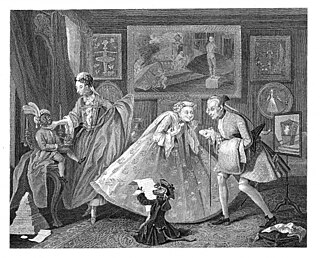
Taste in High Life is an oil-on-canvas painting from around 1742, by William Hogarth. The version seen on the right was engraved by Samuel Phillips in 1798, under commission from John Boydell for a posthumous edition of Hogarth's works, but Phillips's final, third state was not published until 1808.

The Death of Actaeon is a late work by the Italian Renaissance painter Titian, painted in oil on canvas from about 1559 to his death in 1576 and now in the National Gallery in London. It is very probably one of the two paintings the artist stated he had started and hopes to finish in a letter to their commissioner Philip II of Spain during June 1559. However, most of Titian's work on this painting possibly dates to the late 1560s, but with touches from the 1570s. Titian seems never to have resolved it to his satisfaction, and the painting apparently remained in his studio until his death in 1576. There has been considerable debate as to whether it is finished or not, as with other very late Titians, such as the Flaying of Marsyas, which unlike this has a signature, perhaps an indication of completion.
Bernard Baron was a French engraver and etcher who spent much of his life in England.
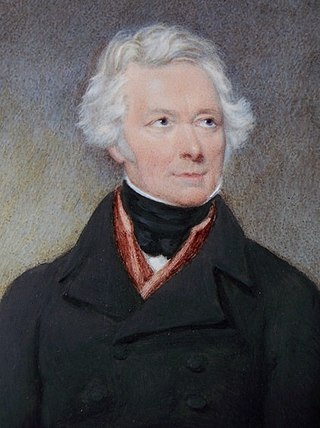
Henri Jean-Baptiste Victoire Fradelle (1778–1865) was a Franco-English Victorian painter and portraitist, specializing in literary, historical, and religious subjects. For more than a hundred years, he was confused with his son, Henry Joseph Fradelle (1805–1872), who was trained as an artist but had several professions, including infirmary supervisor. It was only in the first decade of the 21st century that this mistake was identified and that biographies, lists, and auction houses gave Fradelle his rightful name.

The Lady's Last Stake, originally entitled Piquet: or Virtue in Danger, is a painting by William Hogarth, c. 1759. The work is a conversation piece, capturing the moment when the woman has to make a fateful decision: to be ruined financially, or morally. It was one of Hogarth's last works, commissioned by James Caulfeild, 4th Viscount Charlemont, who allowed Hogarth to select the subject and price.
Joseph Hogarth (1801-1879) was a leading British fine art print publisher, print seller, frame maker and art restorer. He operated from various locations in central London in the middle decades of the nineteenth century. He was working in the field by 1826 and the business continued to operate till 1890, by which time it was under the direction of his two sons.

